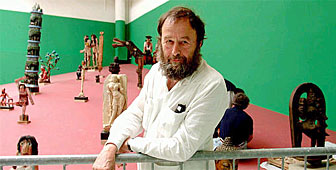Biennale offers artistic “view” on humankind

One of the biggest contemporary art events on the European calendar - the Venice Biennale of Visual Arts - has begun under the direction of Swiss curator Harald Szeemann. It features work by 140 artists from 63 countries and lasts until November 4.
No set theme was applied in choosing the artists – the organisers said it was the artists’ work which decides the dimension of the event. Szeemann has called it “the plateau of humankind”, a phrase he describes as follows:
“The term evokes various associations. It could describe uplands, it might suggest a base and foundation and it’s also a raised platform. The Biennale of Visual Arts therefore hopes to serve as a raised platform offering a view over humankind.”
The “view” takes the form of video art, installations and photographs as well as painting and sculpture, all of it exhibited at various locations all over Venice. Works by artists who contributed to the artistic revolutions of the 20th century can be seen, but most of the exhibits were created by the young and up-and-coming generation.
The work of over a dozen Swiss artists will be on display in Venice over the next five months, but only three of them have been selected by the Federal Culture Office as official representatives.
Urs Lüthi is exhibiting an overview of his works in the Swiss pavilion, while installations by Nobert Möslang and Andy Guhl can be seen in a baroque church next to the Grand Canal.
All three artists are prominent on the Swiss contemporary art scene, although Lucerne-born Lüthi spends much of his time lecturing at the arts academy of Kessel University in Germany. He is a painter specialising in graphic art.
Möslang and Guhl are 49-year-olds from St Gallen who have worked together since 1972. They create installations combining sound, images, objects and space whose avant-garde qualities promise to provide an interesting contrast in styles in their baroque setting in Venice.
by Richard Dawson

In compliance with the JTI standards
More: SWI swissinfo.ch certified by the Journalism Trust Initiative
You can find an overview of ongoing debates with our journalists here. Please join us!
If you want to start a conversation about a topic raised in this article or want to report factual errors, email us at english@swissinfo.ch.